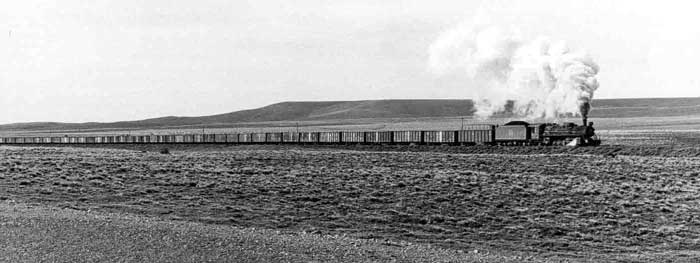
The morning train of empties from Río Gallegos to Río Turbio, hauled by one of the Mitsubishi built, 2-10-2s
is seen about 15 to 20kms into
the journey in 1987. © David Hanna
The
Porta Modified, Japanese built, Sante Fe Locomotives of
Ramal Ferro Industrial
de Río
Turbio
2-10-2s on the 75cm Gauge Hauling Coal Trains weighing up to
2000 tonnes on a daily basis

The morning train of empties from Río Gallegos to Río Turbio, hauled by one of the Mitsubishi built, 2-10-2s
is seen about 15 to 20kms into
the journey in 1987. © David Hanna
Ramal Ferro Industrial de Río Turbio existed because of coal. The Río Turbio coal fields are the only ones of any note in the whole of Argentina. Despite their proximity to Chile it is of little surprise that they have been exploited but perhaps more surprising to find this exploitation did not start in earnest until the Perón era.
Located in the province of Santa Cruz Río Turbio is not at all conveniently located for the vast majority of those requiring coal in Argentina. Buenos Aires is several thousands of kilometres to the north. In those patriotic times such facts were not allowed to stand in the way of progress. Initially the extracted coal was moved by road to the port at Río Gallegos but this was a far from satisfactory situation. Amazing as it may seem today much of the coal was transported in convoys of steam powered waggons built by Sentinel of Shrewsbury, UK.
With the building of the line from Río Gallegos to Río Turbio the three axle Sentinel S6s were relegated to local trip working and scrapping. It is said that L.D. Porta held the Sentinels in high regard.
 |
One
of only two known photographs showing a Sentinel S6 steam waggon in action.
These waggons were locally known as 'Chuffies'. This shot was taken at Río Turbio. Date unknown. © W.Roil - Río Gallegos (pioneer
commercial photographer and historical archive). |
By 2004 just one Sentinel remained. This has been on display at the mines museum in Río Turbio. It is due to be overhauled and returned to service in the near future. However not all of the S6 waggons made it to Río Turbio. Some stayed close to Buenos Aires where one is currently being rebuilt. See this website for some photos.
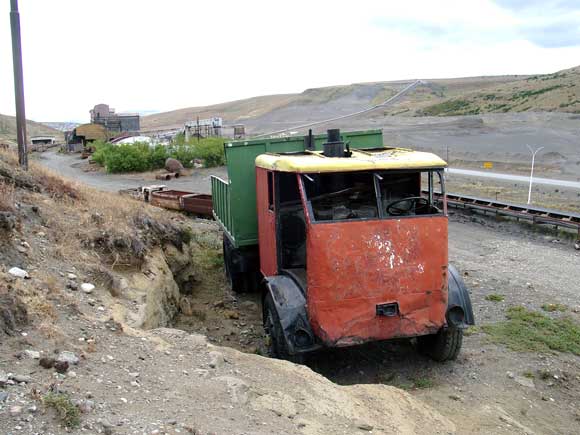 |
The
only remaining Río Turbio Chuffie looking somewhat battered on display at
the mines museum. January 23 2004 |
Initially the 255 km (158.5 miles) long 75cm (2'5 ½") gauge railway was operated by Henschel 2-8-2 type locomotives (taken from the batch delivered in 1922 but not then previously used. Similar machines can still be found working on the famous 'La Trochita' line, Esquel - El Maitén - Ing. Jacobacci, further north in Patagonia) but these proved to be under-powered for the job and unsuited to burning the low grade Río Turbio coal. So this lead to an order being placed with Mitsubishi Mihara, of Japan, for 10 Sante Fe (2-10-2) types. These locomotives, a scaled down version of a 2-10-2 type operating on the Argentine metre gauge, arrived in 1956 but were also soon found to be wanting in the very harsh climate and general operating conditions.
Ing. L.D. Porta, having come to the end of his work with the Argentine state railways, found a new opening for his skills when he became manager of the Río Turbio Railway in 1957. He set about transforming the 2-10-2s into highly competent machines which achieved worldwide recognition amongst engineers and steam enthusiasts alike.

© L.Gutierrez, Tren Rodante, Buenos Aires, Argentina
RFIRT 2-10-2 Specifications (incorporating Porta modifications):
| Running Numbers | 101-110 | 111-120 |
| Year Constructed | 1956 | 1963 |
| Built by | Mihara Eng. Works, Mitsubishi Heavy Industries, Japan | Mihara Eng. Works, Mitsubishi Heavy Industries, Japan |
| Type & Gauge | 2-10-2, 750 mm (2' 5½in") gauge | 2-10-2, 750 mm (2' 5½in") gauge |
| No. Cylinders | 2 | 2 |
| Cylinder Dimensions | 419mm x 441.3mm (16½" x 17 3/8") | 419mm x 441.3mm (16½" x 17 3/8") |
| Coupled wheel diameter | 850mms (33½") | 850mms (33½") |
| Boiler pressure | 1565kPa (227psi) post modification (1372kPa 199psi when built) | 1565kPa (227psi) |
| No. Tubes | 108 | 88 |
| No. Flues | 18 | 18 |
| Superheater | Type A | Type A |
| Heating
Surface (saturated) |
NA | 88.3 m2 (950 square feet) |
| Grate Area | 2.1 m2 (22.5 square feet ) | 2.1 m2 (22.5 square feet ) |
| Fuel | Sub-bituminous coal, ~14% ash, ~2.9 kW (10000 BTU/lb) | Sub-bituminous coal, ~14% ash, ~2.9 kW (10000 BTU/lb) |
| Effective Firebox Volume | 3.54 m3(125 cubic feet ) | 3.54 m3 (125 cubic feet) |
| Adhesive Weight | 38 tons | 38 tons |
| Loco. Weight | 48 tons | 48 tons |
| Max. DB power | 895kW (1200hp)* | 1000kW (1341hp)* |
| DBHP per ton | 25 | 28 |
| Specific fuel consumption | 1.2kg (2.64lb)/DBHP/hour (estimated) | 1kg (2.2lb)/DBHP/hour |
| Rated tonnage | 1200-1500 tons | 1500-2000 tons |
* Achieved at 50 km/h (31mph) (the maximum line speed due to track conditions and poor wagon springing).

© L.Gutierrez, Tren Rodante, Buenos Aires, Argentina
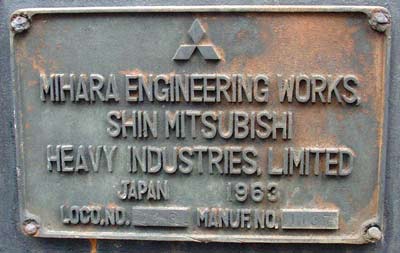 |
Amazingly locos dumped at Rio Turbio still carried plates in 2004. On the left is 113's works plate (works number 1137) and on the right is 106's (incomplete) numberplate. Don't even think about trying to steal them - security at Río Turbio is very good! |
 |
 |
RFIRT 103 at Río Gallegos in the 1970s. © John Kirchner |
As delivered numbers 101-110 were rated at 700 continuous drawbar kW/939 continuous dbhp. However the low grade coal produced at Río Turbio was not (traditionally) ideal steam locomotive fuel. It has a high ash content with a fairly low ash fusion point - ideal for clinker formation. Originally the Henschel 2-8-2s operating the line had neither a rocking or drop grate and really struggled on the local coal! One of the first jobs Porta undertook on arrival at Río Turbio was a thorough assessment of the locomotives as they were. It was found even under the most favourable conditions the locomotives could barely sustain 520 kW/697hp. It was obvious something needed to be done if these Japanese built locos were actually going to prove to be a worthwhile investment.
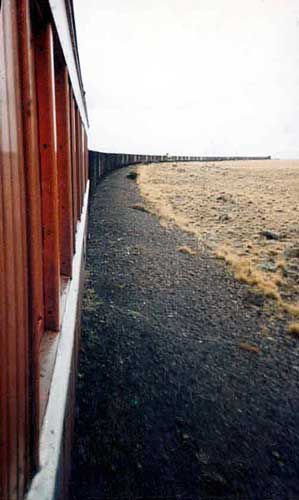 |
Big trains on any gauge, let alone 75cm. 50+ vehicles back and Río Turbio bound in 1992. © C.A.Fox |
As a result of the assessment a modification programme was drawn up by Porta and the local engineering staff. Three locomotives, 104, 108 and 110, were initially modified to prove the features and to allow tuning up to take place. These three machines then formed the template to which the others were modified in later years. That said RFIRT 106 was left as delivered to show all who cared to look just how bad things were with the locomotives in original condition. This may seem like an odd thing to do but with no other reference point how would future generations be able to see why the modified machines were so much better? Interestingly when viewed in January 2004, dumped at Río Turbio, RFIRT 106 was found to be sporting a number of modifications such as a Kylpor ejector. Information is being sought to ascertain when these changes were made or even if the locomotive carrying the number 106 is indeed the genuine 106!
The modifications made to the first batch of locos included:
These modified first series locomotives were to sustain 895kW/1200dbhp indefinitely.
In 1964 RFIRT 111 to 120 were supplied, again by Mitsubishi Mihara. These new machines incorporated all the modifications proved in the first batch along with further enhancements:
 |
A Kylpor ejector more or less as it should be in one of the locos dumped at Río Gallegos. January 2004. |
 |
With the exhaust splitters and mixing chamber missing the lowest level of the Kylpor is revealed to be a 'Maltese Cross' like arrangement. Also note the blower pipes. January 2004 |
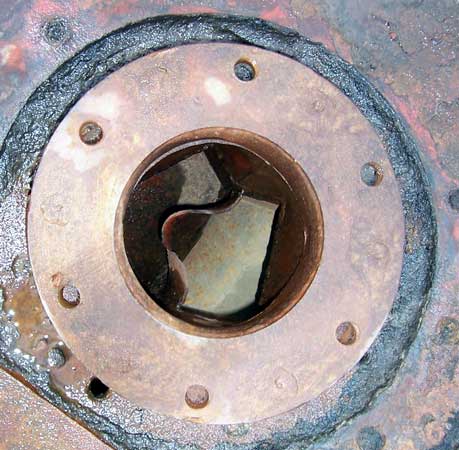 |
And below the first nozzle is the swirl inducing Kordina. April 2005. © Chris Newman. |
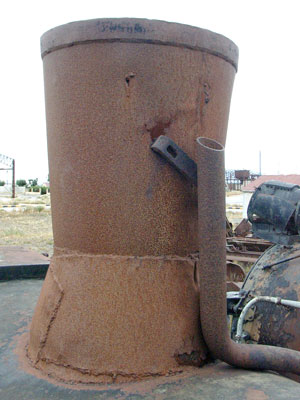 |
A section of the diffuser forms the visible chimney at the rear of which is an auxiliary exhaust. It is important to exhaust auxiliaries separately to the draughting system to maintain optimum draughting conditions. January 2004 |
The locomotives are fitted with 18 Type A superheater elements fed with steam from the dome. The throttle valve is operated via external linkages. Superheated steam temperatures of between 410 - 420°C (770 - 788°F) were the norm when the locomotives were working hard. It is sometimes not appreciated how important high superheat temperatures are to overall efficiency. It should also be noted that higher superheat temperatures would have created lubrication problems. Later, in South Africa, David Wardale was able to achieve higher superheated steam temperatures (approximately 450°C/842°F) but to ensure lubrication employed special valve liners cooled with saturated steam.
 |
A first series boiler as a comparison to the second series shown below shows most of the small tubes remaining in place, as built. However a couple have been permanently removed and the holes welded in whilst others have been replaced by plugs. It is unclear if these plugs were a temporary measure to replace a failed tube or a permanent tube removal followed by replacement with a plug to facilitate boiler washout and inspection. January 2004 |
 |
This view shows the smokebox tubeplate of a second series boiler. The Type A superheater elements are in place and the reduced number of small tubes is obvious. January 2004 |
The boilers are of welded construction. In the period up to 1969 no tubes required repairs for leaks and no stays broke. In part this can be attributed to the use of Dearborn water treatment. These results would normally be impressive but are even more so given the harsh climate with temperatures as low as -20°C/-4°F for lengthy periods. Within the fireboxes were a pair of T security circulators, the bottom legs of which supported the combustion arch.
 |
A view into a withdrawn loco's firebox showing the all welded construction, T security circulators, combustion chamber and the remains of the combustion arch. January 2004. |
The fireboxes were arranged for the Gas Producer Combustion System (GPCS). As designed there were four secondary air/over fire air intakes in firebox crown and four on each side. 70% of the total air required for combustion was admitted via these intakes in addition to air via the always open firehole door, which was of the vertical sliding type. It should be noted despite the very great differences in the temperatures between the inside and outside of the firebox (even in the very coldest of conditions) there were never any stress related problems in the regions of the overfire airholes. It is, of course, very true to say that under all conditions pre-heating of the combustion air would have been of great benefit to overall combustion efficiency.
3-4% of exhaust steam from the cylinders is piped to the ashpan where it mixes with the primary air. This contributed about 30% to the total under fire steam/clinker control steam requirements. Further steam was obtained from the vacuum ejector exhaust and as live (saturated) steam connected to the blower pipework. Feeding steam under the grate is an essential part of the GPCS. The chemistry of combustion helps ensure correct gasification of the coal whilst also providing good protection against clinker formation. The fully rocking grate contained firebars of the Hulson type. It was normal practice to shake the grate at regular intervals to help maintain optimum ash levels in the firebed and thus optimum gas production from the coal.
 |
A general arrangement of the Gas Producer Combustion System on the RFIRT locomotives. Taken from David Wardale's book listed at the end of this piece. |
Unusually for the gauge the locomotives were fitted with mechanical stokers as supplied by Daihatsu. However much hand firing was also carried out by loco crews. A longer than would be normal brick arch was fitted. Not only did this aid good combustion generally but, as Chapleon had shown with the SNCF 240P 4-8-0s, a long combustion arch on a mechanically fired locomotive made a significant contribution to unburnt losses from the firebed/direct from the coal distribution point. In combination with the other GPCS features this helped to ensure minimal unburnt losses from the firebed and combustion zone. Such was the success that tube cleaning was virtually eliminated. The fact it was not showed that despite the great strides forward there was still more to do, as mentioned further on.
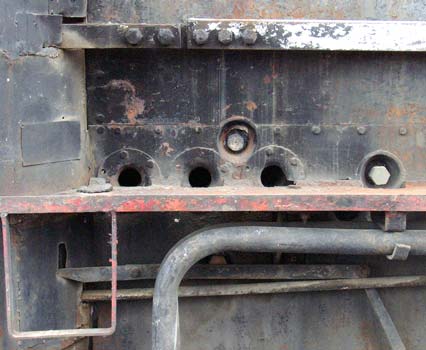 |
Three of the four overfire air holes in the firebox side of a RFIRT 2-10-2. January 2004 |
 |
For some reason best known the the maintenance people on RFIRT this boiler exhibits just two overfire airholes as seen from the inside of the firebox. January 2004. |
 |
Looking up under the grate the rocking sections are clear as is the pipework distributing underfire/clinker control steam. January 2004. |
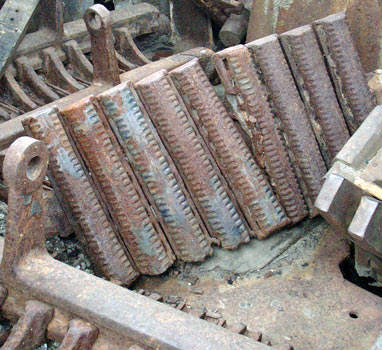 |
Hulson grate sections on the footplate of a loco at Río Gallegos. January 2004 |
 |
The Porta design of vertical sliding firehole door is seen on this loco at Río Turbio above the final stage of the stoker. January 2004 |
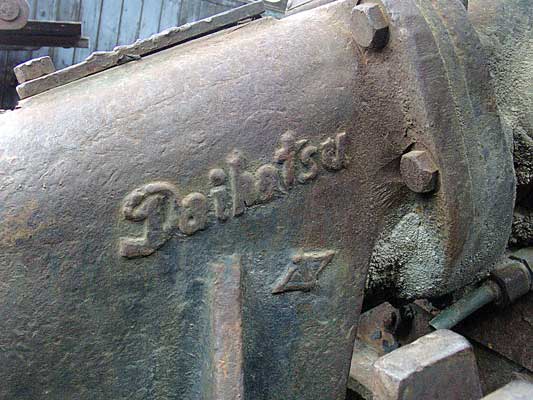 |
Stokers by Daihatsu - the different type of text indicating first batch (left) and second batch (right). January 2004 |
 |
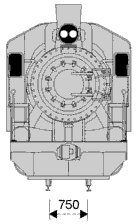
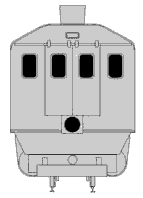 The piston valves were replaced with a new design. Porta employed his then latest thinking in the form of lightweight, articulated, multi-ringed piston valves. They were lightweight to reduce the power required to drive them, overall bearing pressure and thus wear rates, articulated on the valve rod to take up any irregularities in the drive and thus reduce wear and multi-ringed to reduce specific bearing pressure, which improved ring life, and to reduce steam leakage across the valvehead. It is common sense to see that lots of small rings will provide greater steam tightness than a couple of large rings. The load and thus the "job" is spread out. It is also important to note that the valves employed both inlet and exhaust steam diffusers. These devices reduced the "sharpness" of inlet and exhaust events and helped to keep the inlet and exhaust ports cool.
The piston valves were replaced with a new design. Porta employed his then latest thinking in the form of lightweight, articulated, multi-ringed piston valves. They were lightweight to reduce the power required to drive them, overall bearing pressure and thus wear rates, articulated on the valve rod to take up any irregularities in the drive and thus reduce wear and multi-ringed to reduce specific bearing pressure, which improved ring life, and to reduce steam leakage across the valvehead. It is common sense to see that lots of small rings will provide greater steam tightness than a couple of large rings. The load and thus the "job" is spread out. It is also important to note that the valves employed both inlet and exhaust steam diffusers. These devices reduced the "sharpness" of inlet and exhaust events and helped to keep the inlet and exhaust ports cool.
Steel pistons were provided with six narrow piston rings, to standard diesel quality and workmanship. The reason for using multiple narrow rings was, again, to reduce specific bearing pressure, wear rates and increase steam tightness. Fukao gland packings were used which gave extremely good results maintaining steam tightness over nearly 321868km/200000 miles running.
Every 20117km/12500 miles it was necessary to take up play in the axleboxes, which had side bearings to deal with piston thrust wear, by placing shims between the bearing and axlebox. All main bearings were of the plain type. Bronze bearing wedges and horn guides were fitted; these were expected to outlast the economic life of the locomotives.
An early version high adhesion tyre profile was used on these locomotives a key feature of which is the turning of driving wheel tyres 3mm/ 3/32" larger in diameter than the coupled wheels.
 |
At some point the lightweight, articulated Porta type piston valves were altered from having six narrow rings to the type shown here (not in very good or even complete condition) with four steel rings and three bronze lands in between. The modification was not undertaken with Porta's consent. Sadly the inlet and exhaust steam diffusers are missing from this example. These may also have been designed out when the valve was altered. January 2004 |
 |
A multi-ring piston left as scrap amongst the weeds at Río Gallegos. The lands are bronze whilst the rings are diesel engine quality steel. January 2004 |
To give variable lead with the Walschaerts valvegear in use a further modification introduced by Porta - he shortened the eccentric crank. Lead steam was at its maximum with the locomotives were in full forward gear with this decreasing as the cut off was increased. In reverse it was possible for there to be negative lead. However this was not considered a problem as very little work was undertaken in reverse.
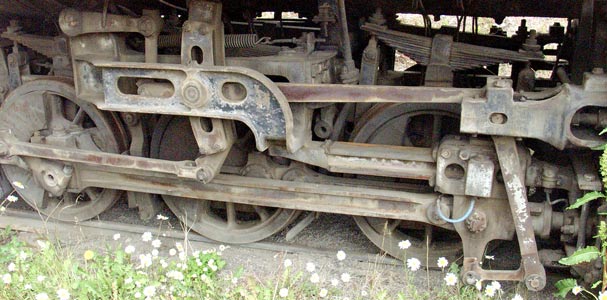 |
The valvegear arrangement on a loco at Río Turbio. January 2004 |
The normal loaded train weight was 1500-1700 tons with the maximum for a single unaided locomotive being set at 2000 tons. 12000km/7456 miles per month was regularly achieved by these 75cm gauge locos.
Testing was undertaken with a carriage rebuilt as a dynamometer test car. Sadly after Porta's departure from the railway the test car was dismantled.
By the then current standards of performance thermal efficiency was excellent and even today would embarrass most steam locomotives:
Undoubtedly the GPCS made a large contribution to these figures. Maximum sustainable evaporation was approximately 22000 lb/hour, an excellent figure from a boiler with just 88.25m2/950ft2 heating surface and a grate area of 2.1m2/22.5ft2 burning coal with a calorific value of just 9000-10000 BTU/lb /2.6-2.9 kW.
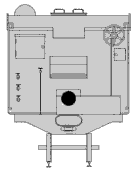
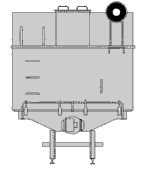 Following Porta's 1961 return to Buenos Aires to head the Thermodynamics section of Instituto Nacional de Tecnologia Industrial (INTI) he remained as a long term consultant to the railway with further development undertaken as the chance arose. It is believed some early experiments with water treatment regimes, to be finalised between 1969 and 1974 on the metre gauge of North West Argentina, were undertaken. But perhaps the most dramatic was a full trial of the next stage in the development of the GPCS for steam railway locomotives. Cyclonic GPCS (C-GPCS) was tried out on No.118. Whilst not perfect, as a first attempt, it gave very promising results. An "igloo" of refractory brick was built within the normal firebox (thus compromising performance somewhat due to the less than perfect layout which resulted) and secondary air arranged to give a cyclonic gas flow were at the heart of the system. On test, burning 11% ash maize-size Río Turbio coal, 118 was able to haul an amazing of 3190
tons train. This train was doubleheaded with a conventional GPCS loco as it was acknowledged on the steepest gradients 118 would be unable to maintain sufficient adhesion to guarantee not to slip to a stand. However the full load was hauled by 118 alone away from these gradients
at 30-35 km/h /18.6-22mph on level track at 35% cut-off.
Following Porta's 1961 return to Buenos Aires to head the Thermodynamics section of Instituto Nacional de Tecnologia Industrial (INTI) he remained as a long term consultant to the railway with further development undertaken as the chance arose. It is believed some early experiments with water treatment regimes, to be finalised between 1969 and 1974 on the metre gauge of North West Argentina, were undertaken. But perhaps the most dramatic was a full trial of the next stage in the development of the GPCS for steam railway locomotives. Cyclonic GPCS (C-GPCS) was tried out on No.118. Whilst not perfect, as a first attempt, it gave very promising results. An "igloo" of refractory brick was built within the normal firebox (thus compromising performance somewhat due to the less than perfect layout which resulted) and secondary air arranged to give a cyclonic gas flow were at the heart of the system. On test, burning 11% ash maize-size Río Turbio coal, 118 was able to haul an amazing of 3190
tons train. This train was doubleheaded with a conventional GPCS loco as it was acknowledged on the steepest gradients 118 would be unable to maintain sufficient adhesion to guarantee not to slip to a stand. However the full load was hauled by 118 alone away from these gradients
at 30-35 km/h /18.6-22mph on level track at 35% cut-off.
 |
The Cyclonic Gas Producer Combustion System furnace. This illustration of the concept applied to RFIRT 118 is taken from the 1969 I.Mech.E paper given by Porta. In this example the firebox is round, thus setup of correct cyclonic conditions. Adapting non-square fireboxes for C-GPCS is quite a challenge. |
After Porta's departure it was almost inevitable that the locos were partially demodified by people who did not have the knowledge or take the time to understand them. It is also true the harsh Patagonian conditions made it very hard to retain good staff. So it was inevitable a lack of consistency in approach and knowledge would result. This was a gradual process which, by the end of steam on RFIRT in 1997, meant locos were running around in various forms with each one seemingly slightly different! It is no surprise to report that in such forms operating problems came to the fore such as lineside fires caused by spark throwing etc, problems which had not existed when Porta had modified the locos. A very similar thing also happened with David Wardale's South African Railway's Class 26 4-8-4 No.3450 as the locomotive was gradually demodified following his departure from South Africa.
Sadly the fall in standards coupled to changes of national policy saw the locos replaced by Eastern European diesel hydraulics in the late 1990s - another case of what Porta would have described as 'handing the diesel salesman the knife by the handle'. It is reassuring to be able to report the diesels have given much trouble proving that no form of traction will survive in service if correct maintenance and overhaul policies are not followed.
 |
113 (left) and 119 on duty at Río Turbio in the 1970s. © John Kirchner |
  |
Two first series locomotives stored at Río Turbio in January 2004. On the left is 104 and on the right 110. Both locos were amongst the first trio to be modified by Porta in the late 1950s. |
 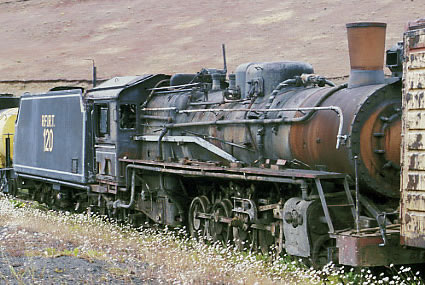 |
Two second series locomotives stored at Río Turbio in January 2004. On the left is 116 (the genuine one?) and on the right, the last of the Sante Fes to be built, 120. |
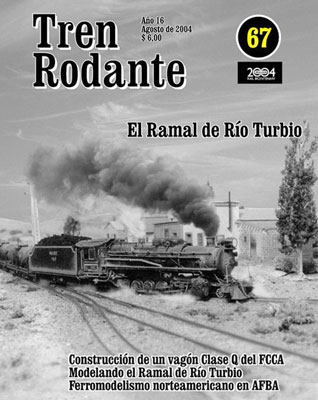 |
Within Argentina the Santa Fe locomotives of RFIRT remain highly regarded and well known about. The August 2004 edition of 'Tren Rodante' included a large article on them. See the Tren Rodante website. |
 Whilst not directly relevant to the 2-10-2s it is interesting to note that Porta applied Río Turbio type modifications to Ferrocarril General Belgrano (FCGB) Class 12A No. 4674. This 48 ton (without tender) machine, was built by Alco in 1919, with 27 tons as useful adhesive weight. As modified 4674 was able maintain 820 drawbar kW/1100 dbhp. It proved that Río Turbio coal was just as suitable for mainline work as it was for the somewhat unique conditions on RFIRT. Following a case of sabotage this loco was to remain a one off.......
Whilst not directly relevant to the 2-10-2s it is interesting to note that Porta applied Río Turbio type modifications to Ferrocarril General Belgrano (FCGB) Class 12A No. 4674. This 48 ton (without tender) machine, was built by Alco in 1919, with 27 tons as useful adhesive weight. As modified 4674 was able maintain 820 drawbar kW/1100 dbhp. It proved that Río Turbio coal was just as suitable for mainline work as it was for the somewhat unique conditions on RFIRT. Following a case of sabotage this loco was to remain a one off.......
It is also interesting to note the modifications to the first batch of locos, leading to the order for the second 10 machines with all  modifications built in, was put out to international tender. Eventually Mitsubishi Mihara won the contract but several well known international firms did bid for the work including Hunslet of Leeds, UK. Their knowledge of the requirement lead directly to the introduction of the GPCS and Kylpors to their 'Austerity' 0-6-0st industrial shunting locomotive. In the end over 70 locos were either built new with the modifications or were retro-fitted at Hunslet's works or at locomotive works near to the base depot of the machines in question.
modifications built in, was put out to international tender. Eventually Mitsubishi Mihara won the contract but several well known international firms did bid for the work including Hunslet of Leeds, UK. Their knowledge of the requirement lead directly to the introduction of the GPCS and Kylpors to their 'Austerity' 0-6-0st industrial shunting locomotive. In the end over 70 locos were either built new with the modifications or were retro-fitted at Hunslet's works or at locomotive works near to the base depot of the machines in question.
Click here to read "TRAVEL EXPERIENCES AT FIFTY TWO SOUTH", by Ken Mills, recounting his encounter with RFIRT in 1972.
To view almost all of the RFIRT photographs the webmaster took in January 2004 see here.
In mid 2004 excellent news started to emerge from Santa Cruz. Millons of US$s of investment are destined for the Río Turbio coal field to modernise and bring it back up to high production rate. Whilst steam was eventually displaced by diesel in 1997 a new use for the locomotives stored at Río Turbio has been found. As part of the project the line is to be extended for tourist purposes with the steam locos being central to this. A 40km extension is planned from Río Turbio to the Chilean town of Puerto Natales. It is planned to tap the considerable tourist traffic in the area but also to offer international and trans-continental freight and passenger services. It is also not beyond the bounds of possibility the unreliable diesels will be replaced by steam on coal trains - this would seem logical given the fuel for the locos comes out of the ground whereas the diesel fuel has to be brought in especially.
The first stage of the scheme is to see locomotives 119 returned to service in fully Porta modified/as built state. Henceforth such machines are to be referred to as the Modified Santa Fe type. This is because it is planned to upgrade 120 to modern standards, that is to incorporate advances made since 1960. This machine will be referred to as an Advanced Santa Fe; it is planned that 120 will the prototype machine. Once proven further locomotives from those stored at Río Turbio will be similarly converted. Additionally 116 (in reality 107!) is in steamable but largely demodified condition. It is intended to one day comprehensively rebuild the loco but for now it will serve as a reminder of how not to do things in the way 106 did in former years.
 |
116 (107) outside the shed at Río Turbio, in something approaching "full" working order. 14 April 2005. © Chris Newman |
An incomplete list of items to be modified includes:
Further details of the plans can be read here.
Interesting times ahead!
A book covering the history of RFIRT, written by retired General Manager Sr. O.A. Boichetta, is currently in preparation. It is to be published by Camden in the UK. Additionally Camden is also to produce a book containing the full text of Porta's 1969 I.Loco.E. lecture.
Additionally the Science and Society Picture Library, in the UK, has a small number of excellent photographs showing RFIRT in the 1970s available for viewing and purchase here.
It is fully acknowledged much of the above text relies heavily on the references below by L.D.Porta and David Wardale. This is not an entirely original piece but, hopefully, a summary of the best writings on these locomotives and their relationship to the RFIRT story.
Acknowledgements:
Many thanks to the following for the help and encouragement received writing this piece and, where relevant, use of photographs:
O.A. Boichetta, R. Campbell, C.A. Fox, L. Gutierrez, D. Hanna, J. Kirchner, S. McMahon, D. Wardale, J. West
All uncredited photographs are © Martyn Bane.